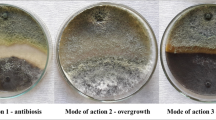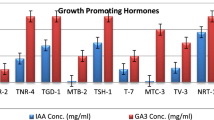Abstract
The efficacy of seven strains of Trichoderma asperellum collected from the fields in Southern China was assessed against Fusarium graminearum (FG) the causal agent of corn stalk rot of maize were in vitro for their antagonistic properties followed by statistical model of principal compound analysis to identify the beneficial antagonist T. asperellum strain. The key factors of antagonist activity were attributed to a total of 13 factors including cell wall degrading enzymes (chitnase, protease and β-glucanases), secondary metabolites and peptaibols and these were analyzed from eight strains of Trichoderma. A linear regression model demonstrated that interaction of enzymes and secondary metabolites of T. asperellum strain ZJSX5003 enhanced the antagonist activity against FG. Further, this strain displayed a disease reduction of 71 % in maize plants inoculated with FG compared to negative control. Pointing out that the T. asperellum strain ZJSX5003 is a potential source for the development of a biocontrol agent against corn stalk rot.




Similar content being viewed by others
References
Marasas WFO, Nelson PE, Toussoun TA (1984) Toxigenic Fusarium species: identity and mycotoxicology. The Pennsylvania State University Press, University Park
Harman GE, Howell CR, Viterbo A, Chet I, Lorito M (2004) Trichoderma species—opportunistic, avirulent plant symbionts. Nat Rev Microbiol 2:43–56. doi:10.1038/nrmicro797
Lorito M, Farkas V, Rebuffat S, Bodo B, Kubicek CP (1996) Cell wall synthesis is a major target of mycoparasitic antagonism by Trichoderma harzianum. J Bacteriol 178:6382–6385
Harman GE, Herrera-Estrella AH, Horwitz BA, Lorito M (2012) Special issue: Trichoderma—from basic biology to biotechnology. Microbiology 158:1–2. doi:10.1099/mic.0.056424-0
Schmoll M, Schuster A (2010) Biology and biotechnology of Trichoderma. Appl Microbiol Biotechnol 87:787–799. doi:10.1007/s00253-010-2632-1
Shoresh M, Mastouri F, Harman G (2010) Induced systemic resistance and plant responses to fungal biocontrol agents. Annu Rev Phytopathol 48:21–43. doi:10.1146/annurev-phyto-073009-114450
Lorito M, Woo SL, Harman GE, Monte E (2010) Translational research on Trichoderma: from ‘omics to the field. Annu Rev Phytopathol 48:395–417. doi:10.1146/annurev-phyto-073009-114314
Chet T (1987) Trichoderma—application, mode of action, and potential as a biocontrol agent of soil-borne plant pathogenic fungi. In: Chet P (ed) Innovative approaches to plant disease control. Wiley, New York, pp 137–160
Wiest A, Grzegorski D, Xu BW, Goulard C, Rebuffat S, Ebbole DJ, Bodo B, Kenerley C (2002) Identification of peptaibols from Trichoderma virens and cloning of a peptaibols synthetase. J Biol Chem 227:20862–20868
Vinale F, Marra R, Scala F, Ghisalberti EL, Lorito M, Sivasithamparam K (2006) Major secondary metabolites produced by two commercial Trichoderma strains active against different phytopathogens. Lett Appl Microbiol 43:143–148. doi:10.1111/j.1472-765X.2006.01939.x
Sun R (2013) Resource collection, identification and biocontrol evaluation of Trichoderma isolated from Southern China. Master thesis, Shanghai Jiao Tong University
Wang B, LI G, Guo Y, Chen J (2012) Comparison of antagonistic effects of four Trichoderma strains. Chin J Biol Control 28:147–151
Morton DJ, Stroube WH (1955) Antagonistic and stimulating effects of soil micro-organism of Sclerotium. Phytopathology 45:417–420
Li Y, Fu K, Gao S, Wu Q, Fan L, Chen J (2013) Impact on bacterial community in midguts of the Asian Corn Borer Larvae by transgenic Trichoderma strain overexpressing a heterologous chit42 gene with chitin-binding domain. PLoS One 8:e55555. doi:10.1371/journal.pone.0055555
Silva BDS, Ulhoa CJ, Batista KA, Yamashita F, Fernandes KF (2011) Potential fungal inhibition by immobilized hydrolytic enzymes from trichoderma asperellum. J Agri Food Chem 59:8148–8154. doi:10.1021/jf2009815
Noronha EF, Ulhoa CJ (2000) Characterization of a 29-kDa beta-1,3-glucanase from Trichoderma harzianum. FEMS Microbiol Lett 183:119–123. doi:10.1111/j.1574-6968.2000.tb08944.x
Lowry OH, Rosebrough NJ, Farr AL, Randall RJ (1951) Protein measurement with the Folin phenol reagent. J Biol Chem 193:265–275
Xie G, Zheng X, Qi X, Cao Y, Chi Y, Su M, Ni Y, Qiu Y, Liu Y, Li H, Zhao A, Jia W (2010) Metabonomic evaluation of melamine-induced acute renal toxicity in rats. J Proteome Res 9:125–133. doi:10.1021/pr900333h
Xie G, Ye M, Wang Y, Ni Y, Su M, Huang H, Qiu M, Zhao A, Zheng X, Chen T, Jia W (2009) Characterization of Pu-erh tea using chemical and metabolic profiling approaches. J Agric Food Chem 57:3046–3054. doi:10.1021/jf804000
Ni Y, Su MM, Qiu YP, Chen MJ, Liu YM, Zhao AH, Jia W (2007) Metabolic profiling using combined GC-MS and LC-MSprovides a systems understanding of aristolochic acid-induced nephrotoxicity in rat. FEBS Lett 581:707–711. doi:10.1016/j.febslet.2007.01.036
Li J, Fu J, Yan X, Li H (2006) Analysis of temporal dynamics of Curvularia leaf spot of maize (Curvularia lunata) epidemic and yield loss. J Shengyang Agric Univ 37:835–838
Viterbo A, Ramot O, Chemin L, Chet I (2002) Significance of lytic enzymes from Trichoderma spp. in the biocontrol of fungal plant pathogens. Anton Leeuw Int J 81:549–556
Qualhato TF, Lopes FAC, Steindorff AS, Brandão RS, Jesuino RSA, Ulhoa CJ (2013) Mycoparasitism studies of Trichoderma species against three phytopathogenic fungi: evaluation of antagonism and hydrolytic enzyme production. Biotechnol Lett 35:1461–1468. doi:10.1007/s10529-013-1225-3
Atanasova L, Crom SL, Gruber S, Coulpier F, Seidl-Seiboth V, Kubicek CP, Druzhinina IS (2013) Comparative transcriptomics reveals different strategies of Trichoderma mycoparasitism. BMC Genom 14:121. doi:10.1186/1471-2164-14-121
Mahmoud HE, Amgad AS, Anas E, Younes YM (2015) Characterization of novel Trichoderma asperellum isolates to select effective biocontrol agents against tomato fusarium wilt. Plant Pathol J 31:50–60. doi:10.5423/PPJ.OA.09.2014.0087
Rodríguez MA, Cabrera G, Godeas A (2012) Soil-borne fungi act as biocontrol agents: the role of antifungal metabolite production. In: Brar SK (ed) Biocontrol: management, process and challenges. Nova Science Publishers, New York, pp 63–80
Daniel JF, Filho ER (2007) Peptaibols of Trichoderma. Nat Prod Rep 24:1128–1141. doi:10.1039/B618086H
Szekeres A, Leitgeb B, Kredics L, Antal Z, Hatvani L, Manczinger L, Vagvolgyi C (2005) Peptaibols and related peptaibiotics of Trichoderma. A review. Acta Microbiol Immunol Hung 52:137–168. doi:10.1556/AMicr.52.2005.2.2
Dubey SC, Tripathi A, Dureja P, Grover A (2011) Characterization of secondary metabolites and enzymes produced by Trichoderma species and their efficacy against plant pathogenic fungi. Indian J Agr Sci 81:455–461
Luo Y, Zhang DD, Dong XW, Zhao PB, Chen LL, Song XY, Wang XJ, Chen XL, Shi M, Zhang YZ (2010) Antimicrobial peptaibols induce defense responses and systemic resistance in tobacco against tobacco mosaic virus. FEMS Microbiol Lett 313:120–126. doi:10.1111/j.1574-6968.2010.02135.x
Keswani C, Mishra S, Sarma BK, Singh SP, Singh HB (2014) Unraveling the efficient applications of secondary metabolites of various Trichoderma spp. Appl Microbiol Biotechnol 98:533–544. doi:10.1007/s00253-013-5344-5
Sanz L, Montero M, Grondona I, Vizcaíno JA, Llobell A, Hermosa R, Monte E (2004) Cell wall-degrading isoenzyme profiles of Trichoderma biocontrol strains show correlation with rDNA taxonomic species. Curr Genet 46:277–286. doi:10.1007/s00294-004-0532-6
Larralde-Corona CP, Santiago-Mena MR, Sifuentes-Rincon AM, Rodriguez-Luna IC, Rodriguez-Perez MA, Shirai K, Narvaez-Zapata JA (2008) Biocontrol potential and polyphasic characterization of novel native Trichoderma strains against Macrophomina phaseolina isolated from sorghum and common bean. Appl Microbiol Biotechnol 80:167–177. doi:10.1007/s00253-008-1532-0
Saravanakumar K, Yu C, Dou K, Wang M, Li Y, Chen J (2016) Synergistic effect of Trichoderma-derived antifungal metabolites and cell wall degrading enzymes on enhanced biocontrol of Fusarium oxysporum f. sp. cucumerinum. Biol Control 94:37–46. doi:10.1016/j.biocontrol.2015.12.001
Lorito M, Peterbauer C, Hayes CK, Harman GE (1994) Synergistic interaction between fungal cell wall degrading enzymes and different antifungal compounds enhances inhibition of spore germination. Microbiology 140:623–629. doi:10.1099/00221287-140-3-623
Acknowledgments
We thank the financial support from the Special Project of Basic Work for Science and Technology (2014FY120900), the key project of the basic research of Shanghai Municipal Science and Technology Commission (12JC1404600), Natural Science Foundation of China (No. 31201557), Natural Science Fund of Shanghai (No.12ZR1414100), the special fund of Modern Agricultural Industry Technology System (CARS-02), Ministry of Education University Doctoral Foundation (No. 20120073120070), and the SJTU Medical-Engineering Cross Research Fund (No. YG2015MS37).
Author information
Authors and Affiliations
Corresponding author
Ethics declarations
Conflict of interest
The authors declare that there are no conflicts of interest.
Electronic supplementary material
Below is the link to the electronic supplementary material.
Rights and permissions
About this article
Cite this article
Li, Y., Sun, R., Yu, J. et al. Antagonistic and Biocontrol Potential of Trichoderma asperellum ZJSX5003 Against the Maize Stalk Rot Pathogen Fusarium graminearum . Indian J Microbiol 56, 318–327 (2016). https://doi.org/10.1007/s12088-016-0581-9
Received:
Accepted:
Published:
Issue Date:
DOI: https://doi.org/10.1007/s12088-016-0581-9




